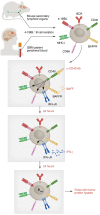Next-generation antigen-presenting cell immune therapeutics for gliomas
- PMID: 36719372
- PMCID: PMC9888388
- DOI: 10.1172/JCI163449
Next-generation antigen-presenting cell immune therapeutics for gliomas
Abstract
Antigen presentation machinery and professional antigen-presenting cells (APCs) are fundamental for an efficacious immune response against cancers, especially in the context of T cell-centric immunotherapy. Dendritic cells (DCs), the gold standard APCs, play a crucial role in initiating and maintaining a productive antigen-specific adaptive immunity. In recent decades, ex vivo-differentiated DCs from circulating CD14+ monocytes have become the reference for APC-based immunotherapy. DCs loaded with tumor-associated antigens, synthetic peptides, or RNA activate T cells with antitumor properties. This strategy has paved the way for the development of alternative antigen-presenting vaccination strategies, such as monocytes, B cells, and artificial APCs, that have shown effective therapeutic outcomes in preclinical cancer models. The search for alternative APC platforms was initiated by the overall limited clinical impact of DC vaccines, especially in indications such as gliomas, a primary brain tumor known for resistance to any immune intervention. In this Review, we navigate the APC immune therapeutics' past, present, and future in the context of primary brain tumors.
Conflict of interest statement
Figures



Similar articles
-
Phenotypic profile of dendritic and T cells in the lymph node of Balb/C mice with breast cancer submitted to dendritic cells immunotherapy.Immunol Lett. 2016 Sep;177:25-37. doi: 10.1016/j.imlet.2016.07.009. Epub 2016 Jul 14. Immunol Lett. 2016. PMID: 27423825
-
Effective cancer immunotherapy by natural mouse conventional type-1 dendritic cells bearing dead tumor antigen.J Immunother Cancer. 2019 Apr 8;7(1):100. doi: 10.1186/s40425-019-0565-5. J Immunother Cancer. 2019. PMID: 30961656 Free PMC article.
-
Dendritic cell-based immunotherapy of malignant gliomas.Cancer Invest. 2004;22(3):405-16. doi: 10.1081/cnv-200034909. Cancer Invest. 2004. PMID: 15493362 Review.
-
Precision cancer immunotherapy: optimizing dendritic cell-based strategies to induce tumor antigen-specific T-cell responses against individual patient tumors.J Immunother. 2015 May;38(4):155-64. doi: 10.1097/CJI.0000000000000075. J Immunother. 2015. PMID: 25839441
-
RNA-loaded dendritic cells: more than a tour de force in cancer therapeutics.Immunotherapy. 2019 Sep;11(13):1129-1147. doi: 10.2217/imt-2019-0058. Epub 2019 Aug 8. Immunotherapy. 2019. PMID: 31390917 Review.
Cited by
-
Telomere maintenance mechanism subtype reveals different immune activity in vestibular schwannoma.J Neurooncol. 2023 Oct;165(1):113-126. doi: 10.1007/s11060-023-04458-5. Epub 2023 Oct 21. J Neurooncol. 2023. PMID: 37864645 Free PMC article.
-
Elevated Antigen-Presenting-Cell Signature Genes Predict Stemness and Metabolic Reprogramming States in Glioblastoma.Int J Mol Sci. 2025 Aug 1;26(15):7411. doi: 10.3390/ijms26157411. Int J Mol Sci. 2025. PMID: 40806540 Free PMC article.
-
NLRC5-CIITA Fusion Protein as an Effective Inducer of MHC-I Expression and Antitumor Immunity.Int J Mol Sci. 2023 Apr 13;24(8):7206. doi: 10.3390/ijms24087206. Int J Mol Sci. 2023. PMID: 37108368 Free PMC article.
-
Platinum-based chemotherapy promotes antigen presenting potential in monocytes of patients with high-grade serous ovarian carcinoma.Front Immunol. 2024 Sep 9;15:1414716. doi: 10.3389/fimmu.2024.1414716. eCollection 2024. Front Immunol. 2024. PMID: 39315092 Free PMC article.
-
Research landscape of glioma and inflammation over the past two decades.Front Immunol. 2025 Aug 13;16:1605346. doi: 10.3389/fimmu.2025.1605346. eCollection 2025. Front Immunol. 2025. PMID: 40881678 Free PMC article.
References
Publication types
MeSH terms
Substances
Grants and funding
LinkOut - more resources
Full Text Sources
Research Materials
Miscellaneous

